#Turtle exoskeleton fossil
Explore tagged Tumblr posts
Photo

RARE: Turtle Exoskeleton Fossil – Barton Beds, Eocene, Whitecliff Bay, Isle of Wight UK
This listing features a rare fossilised turtle exoskeleton fragment, sourced from the Barton Beds at Whitecliff Bay, Isle of Wight, UK. This specimen dates to the Eocene Epoch, making it over 40 million years old and a significant piece of the UK’s palaeontological heritage.
Fossil Type:
Specimen: Turtle Exoskeleton (Shell fragment – likely carapace or plastron)
Represents a chelonian (turtle or tortoise) from the Eocene vertebrate assemblage of southern England
Geological Context:
Period: Paleogene
Epoch: Eocene
Stage: Bartonian (~41.3 to 38 million years ago)
Formation: Barton Group (formerly part of the “Barton Beds”)
Depositional Environment: Coastal lagoon and estuarine settings. The Barton Beds were laid down in a warm, subtropical marine and marginal marine environment rich in vertebrate and invertebrate fossils.
Morphological Features:
Curved or slightly flattened dermal bone typical of chelonian shell fragments
Surface may show granular texture or faint impressions of scute boundaries
Brown-grey fossilisation with natural wear and mineralisation from estuarine clays
Scientific Importance:
Fossil turtle material from the Barton Beds is rare and valuable for understanding Eocene coastal ecosystems in Britain
Specimens like this may be attributable to genera such as Trionyx or other soft-shelled or hard-shelled turtle lineages found in European Eocene sites
These fossils help reconstruct the palaeobiogeography of marine reptiles in the early Cenozoic
Locality Information:
Whitecliff Bay, Isle of Wight, UK – a historically significant fossil site with well-exposed Barton Beds yielding both marine and terrestrial Eocene fossils. A known locality for rare turtle remains, crocodile teeth, and fish fossils
Authenticity & Display:
All of our fossils are 100% Genuine Specimens and are provided with a Certificate of Authenticity. The photographs show the actual fossil for sale. Please see the photo for full sizing – note that the scale rule cube = 1cm.
This is a scientifically intriguing and display-worthy Eocene turtle exoskeleton fossil from one of Britain’s most productive fossil sites. A fine addition to any fossil collection, especially for those interested in ancient reptiles or the palaeontology of the British Isles.
Own a real piece of early Cenozoic history—fossilised remains from over 38 million years ago!
#Turtle exoskeleton fossil#Barton Beds fossil turtle#Eocene turtle shell#Whitecliff Bay fossil#Isle of Wight fossil reptile#rare UK turtle fossil#Eocene vertebrate fossil#fossil carapace fragment#British fossil turtle shell#certified turtle fossil specimen
0 notes
Text
Archovember 2024 Day 29 - Campylognathoides zitteli
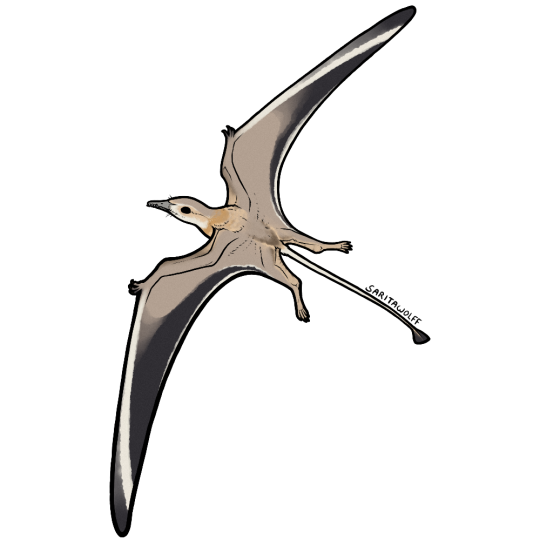
Living in Early Jurassic Germany, Campylognathoides zitteli was a small early pterosaur with comparatively long wings. Its large eyes may have reflected a nocturnal lifestyle. Gut contents have been found and include the belemnoid cephalopod Clarkeiteuthis conocauda, so Campylognathoides likely ate aquatic invertebrates and even large insects, though its teeth were not as long and specialized as its contemporary Dorygnathus. Its shorter, stronger teeth may have allowed it to crack through the exoskeletons of invertebrate prey, and its long wings may have allowed it to swiftly dart after flying insects and catch them on the wing like a kestrel or mastiff bat!

Found in the Sachrang Formation, Campylognathoides zitteli lived at the edge of a shallow epicontinental sea. Aside from Dorygnathus, it would have also lived alongside the long-tailed rhamphorhynchid Parapsicephalus. On land, it could have come across the sauropod Ohmdenosaurus. But much more is known about the sea of this formation, and Campylognathoides could have caught glimpses of hybodonts, chimaeras, schools of ray-finned fish, coelacanths, ichthyosaurs, plesiosaurs, sphenodonts, marine turtles, and marine crocodylomorphs beneath the waves.

(This fossil is of C. liasicus, a Campylognathoides species with comparatively shorter wings)
This art may be used for educational purposes, with credit, but please contact me first for permission before using my art. I would like to know where and how it is being used. If you don’t have something to add that was not already addressed in this caption, please do not repost this art. Thank you!
#Campylognathoides zitteli#Campylognathoides#Novialoid#pterosaurs#archosaurs#archosauromorphs#reptiles#Archovember#Archovember2024#Dinovember#Dinovember2024#SaritaDrawsPalaeo#Early Jurassic#Germany#Sachrang Formation
25 notes
·
View notes
Text
The day before yesterday, I drove to SE Idaho to go to some fossil beds and to see displays of fossils from the area (as well as some from nearby states because this was all one large wetlands region before concepts like states existed). I will post more about this stuff later.
The other part of this trip was to test out camping in my car to see if traveling around by myself and sleeping in relative comfort was possible for me.

Here is my bed setup! In the front passenger's seat is all of my food storage, including an electric cooler that is acting as my refrigerator. The floor behind the driver's seat is my "closet" (where I am storing my towel, toiletries, and duffel bag lol) and is accessible from inside the car in bed mode. Everything stashes away nicely. I even have solar panels and my Bluetti battery in there, three gallons of water (plus my 2L hydration bottle and 32oz hydroflask). A 1.5" memory foam pad serves as the matress, and there are blackout shades that fit perfectly into the windows for privacy, though I hadn't put them up for this photograph. It has turned out to be rather cozy.
Since childhood, I've really loved making small, enclosed spaces that I could crawl into and feel cocooned. My car feels like I made the best little blanket fort, which is kind of wild to me. I could probably enjoy staying like this—as long as I had access to a bathroom and shower—for quite a while!
Prioritizing lots of pillows (including an armchair pillow thing) was the way to go. I have reclined in my pod and read, edited, and watched movies before sleeping each night. It feels like being a little rolly poly, and the car is my exoskeleton. Or I am a turtle, and the inside of my shell is AWEOME. A cave bear with a SICK den. Even when I go back home, I might set it up sometimes just to have a fort.
#personal#car camping#boondocking#fossils#paleontology#paleontology road trip#idaho#hagerman fossil beds#wayan formation
12 notes
·
View notes
Text
Vertebrates 2/24
today in verts we talked about turtles. apparently, turtles have a lot going on that make them super freaky when it comes to their sister taxa.
Lets start with this question: What exactly ARE turtles?
Order Testundies
Sauropsida
Only 361 alive species across 14 families
Instantly recognizeable because of shell
What is so weird about them?
Turtles have anapsid skulls, and are the only amniotes (vertebrates that lay amniotic eggs) with this condition
What is an anapsid skull?
Anapsid skull is a type of Temporal Fenestration.
Temporal fenestrae are openings in the skull that are behind the eyes which allow movement of the lower jaw.
Anapsid means no fenestra, so the only opening are the orbits (eye holes) and nostrils. (turtles)
Synapsid means single fenestra, which is the lower fenestra. (this is what humans have, including mammals and mammal like reptiles)
Diapsid means two fenestrae, which are upper and lower. (lepidosaurs and archosaurs [lizards/snakes, crocodiles/dinosaurs/birds, respectively])
The big question with turtles anapsid skulls is: were they always this way, or did they lose their synapsid/diapsid condition?
The answer comes from the fossil record. In the past we can see that the synapsid condition appears in turtles once in the synapsid lineage, and the diapsid condition appears once in the sauropsid lineage. This proves that turtles evolved to have the anapsid condition in their skull, making it a secondary condition.
2. Modern turtles lack teeth
Jaws of turtles are surrounded by a hard keratinous sheath. Keratin is the same thing our fingernails are made of, but this is a much thicker and denser makeup of it. It has a very sharp beaklike shape that is good for cutting plant and animal material. This is good, because most turtles are omnivores or carnivores.
There are some turtles that are herbivores, but these are usually stenophagous (specific diet) and only eat a certain food in general.
3. Modern turtles are divided into two groups
Cryptodira
262/361 species belong here
head retracts as a vertical S-bend
known as "S-necked" turtles
found in fresh water, marine, and terrestrial
Pleurodira
99/361 species belong here
head retracts by bending horizontally into shell
known as "side-necked" turtles
All freshwater
4. Turtle Shells
Formed by 3 elements
Endoskeleton (spine, ribs, clavical)
Exoskeleton (dermis)
Epidermis (keratinous scutes)
Two halves of shell are:
carapace (top)
plastron (bottom)
The carapace is covered in scutes, which are the individual outlined shapes on top. Under the carapace is bone, dermal and endochondral. Dermal bone is the lower layer and endochondral is the upper layer.
Now lets talk about the types of shells:
Hinged shell
Hinge in the middle that allows the plastron to close the front and back opening of the shell
OR
Double hinge on either end
Weird shells
Lack keratinous scutes and bony plates are reduced
OR
Lack keratinous scutes and the bony plates are replaced by thousands of dermal bone
Evidence of turtles date back to the triassic period
5. How do turtles breathe?
Before getting into this, it is important to note that during development, turtles ribs fuse to their shell, which is good because it reinforces their shell, but it also changes how they breathe in comparison to other amniotes.
Amniotes use a process called costal ventilation, which is where when the lungs expand with air, the ribcage moves with it, and then when the lungs exhale, the ribcage goes back to normal. Because turtles cannot move their fused ribcage, they had to adapt a new way of breathing.
Instead of moving their lungs, turtles move their guts!
when the turtle inhales, the lungs expand. a few muscles and membranes surrounding the guts stretch and allow the lungs to push their gut downward
when the turtle exhales, the muscles and membranes push the guts back up towards the deflating lungs
This causes problems for many turtles functions.
when a turtle is fully retracted inside of its shell, it cannot breathe and must hold its breath
Sea turtles cannot breathe when they walk. they must walk, then take a break to breathe
Most turtles can breathe when they walk due to their diagonal gait. They walk with their left back foot and right front foot, and then right back foot and left front foot.
Aquatic turtles must come up for air, which makes them vulnerable to predators. Luckily, they can hold their breath for a very long time.
There is another way for turtles to breathe which is honestly pretty funny. I'm being completely serious when I tell you, some of them can breathe through their buttholes. They literally open their butthole over and over and pump water in and out and are able to diffuse oxygen from the water. This is really good for them to not have to surface, especially for turtles who get trapped under ice in colder months.
6. Turtle reproduction!
Lay on average 4-5 eggs, or even up to 100 eggs!
Almost no parental care, layed egg and then you are on your own!
Temperature dependent sex determination (TSD):
temperature determines sex of turtle. (Humans are the organism with gender, everything else is sorted by sex)
changes of even 3-4 degrees can determine sex
Lower temps mean males while higher temps mean females
Challenges of reproduction:
Few eggs and slow maturity mean turtles do not reproduce fast enough to combat endangerment
Pet trading, food collection, medicine, habitat destruction, and pollution all affect turtles
Global warming effects TSD and creates a disproportionate ratio of sexes which affects future reproduction as well
Over half of the 361 species are endangered
In conclusion, turtles are funky. We need to protect them to ensure they stay on our earth!
3 notes
·
View notes
Text
fell asleep wondering how body disposal would work in a world were humans evolved more like turtles or giant clams, and had a thick carapace, huge and tougher than our current skeletal system. imagine how inconvenient it would be for a murderer trying to get rid of a body--how do u dispose of the giant fucking shell? also coffins would be a different shape, more like an ellipsoid? human skeletons usually take less than a century to disintegrate, but imagine if we had a exoskeleton that was prone to fossilization. the study of archeology would be very, very affected. also i assume we wouldn't be able to sleep on our backs anymore? how would beds be shaped. what would a world run by turtle-humans look like. would we cover our shells with fabric/clothing or decorate them like we do fingernails? or just straight up do airbrush art? would graffiti be a social issue? someone spray paints u while you're sleeping and u have to pay to have your shell professionally sandpapered? there are so many sociological implications
these are the thoughts that come to me at night
#apparently it takes most people less than 20 minutes to fall asleep.#I want. to hunt those people for sport.
10K notes
·
View notes
Text
Strider Lavagante Lore!!!
With the new discovery of strider’s being lobsters, here’s a list of all the facts my wonderful girlfriend @imthatwannabeauthor informed me of, the next reblog will be a list of new headcanons formed from this.

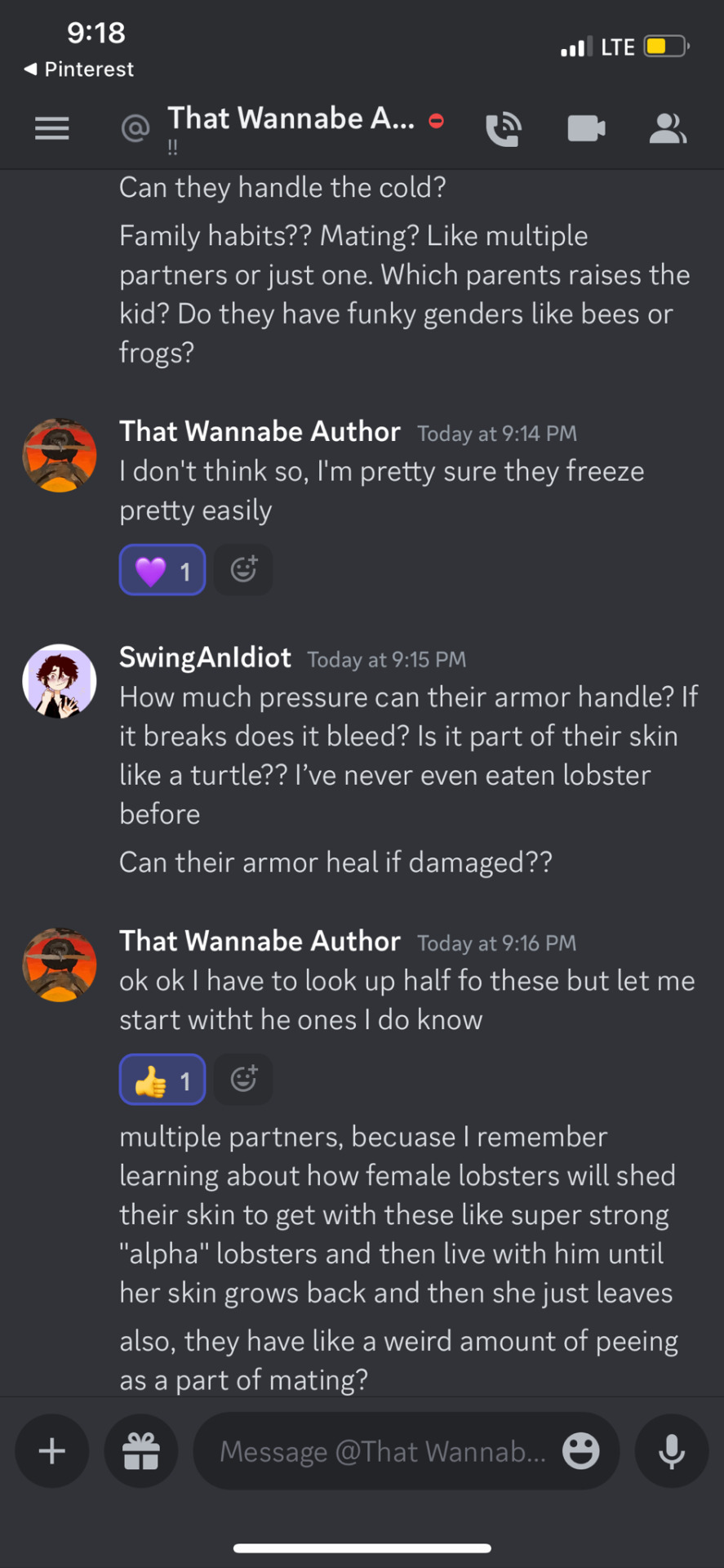
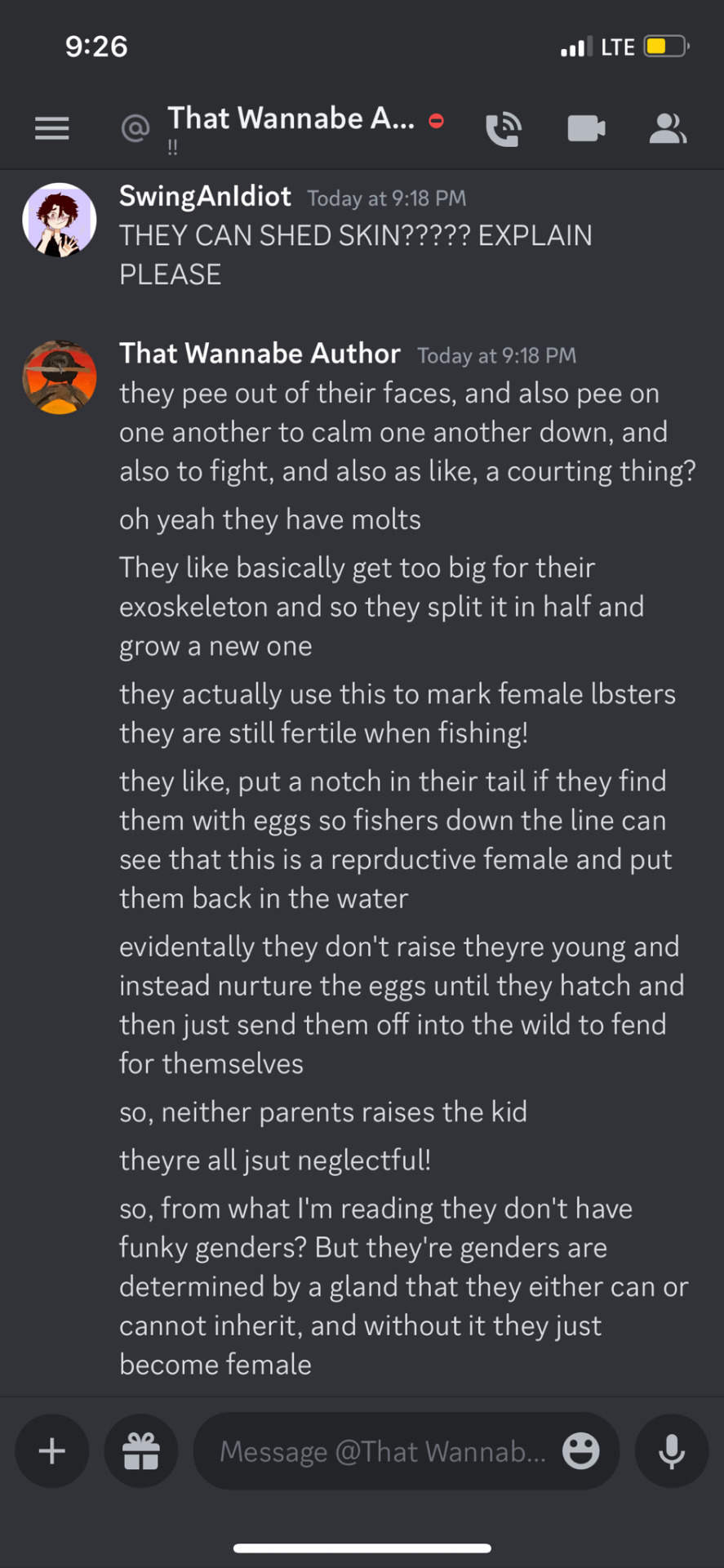

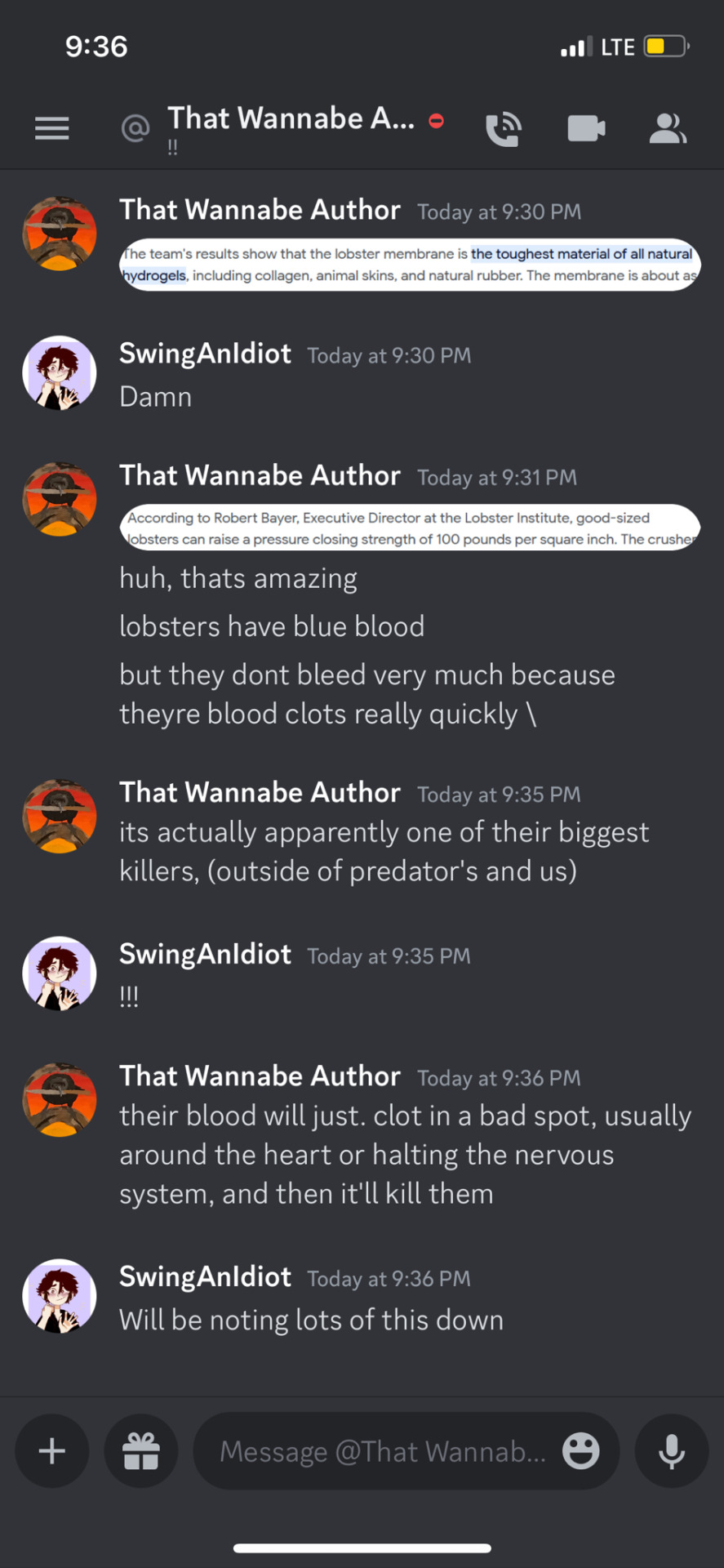
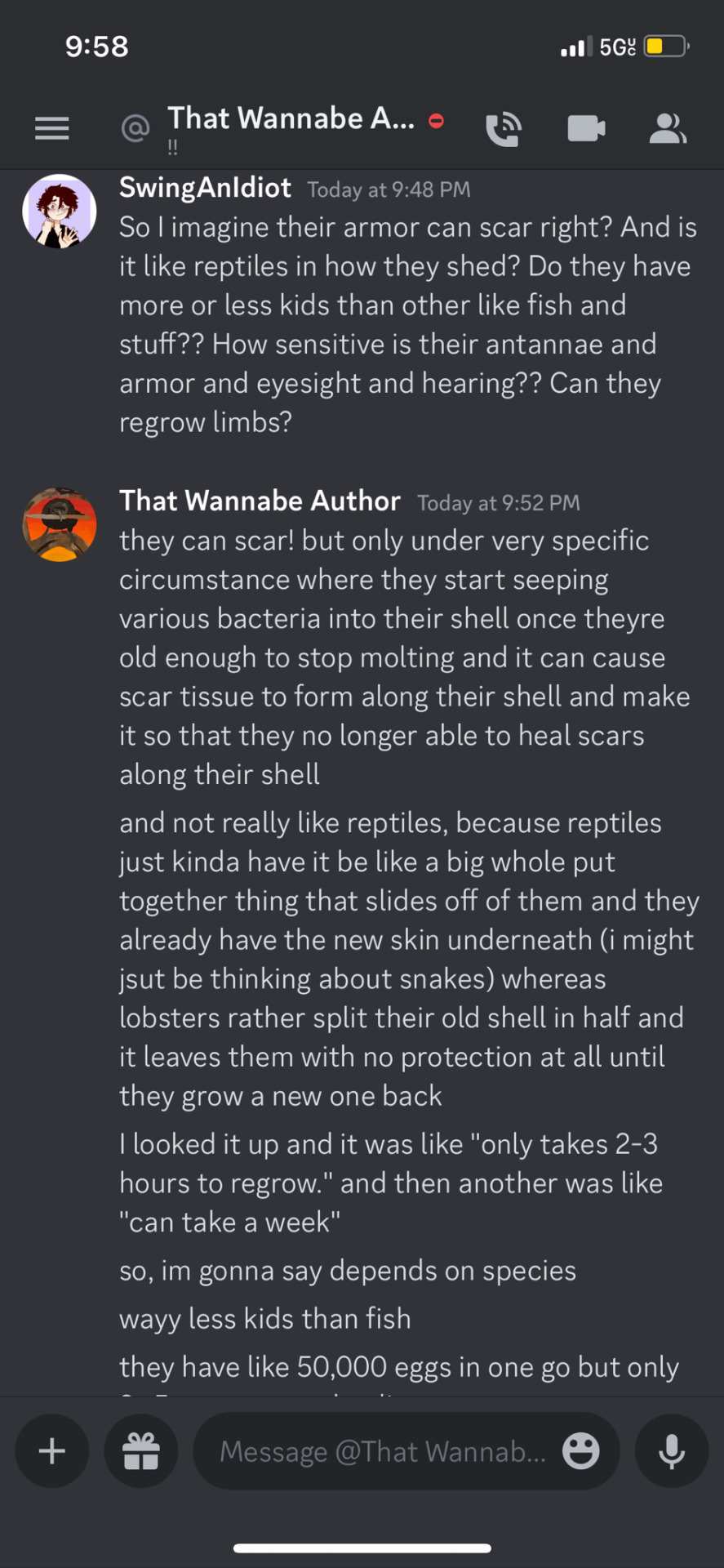


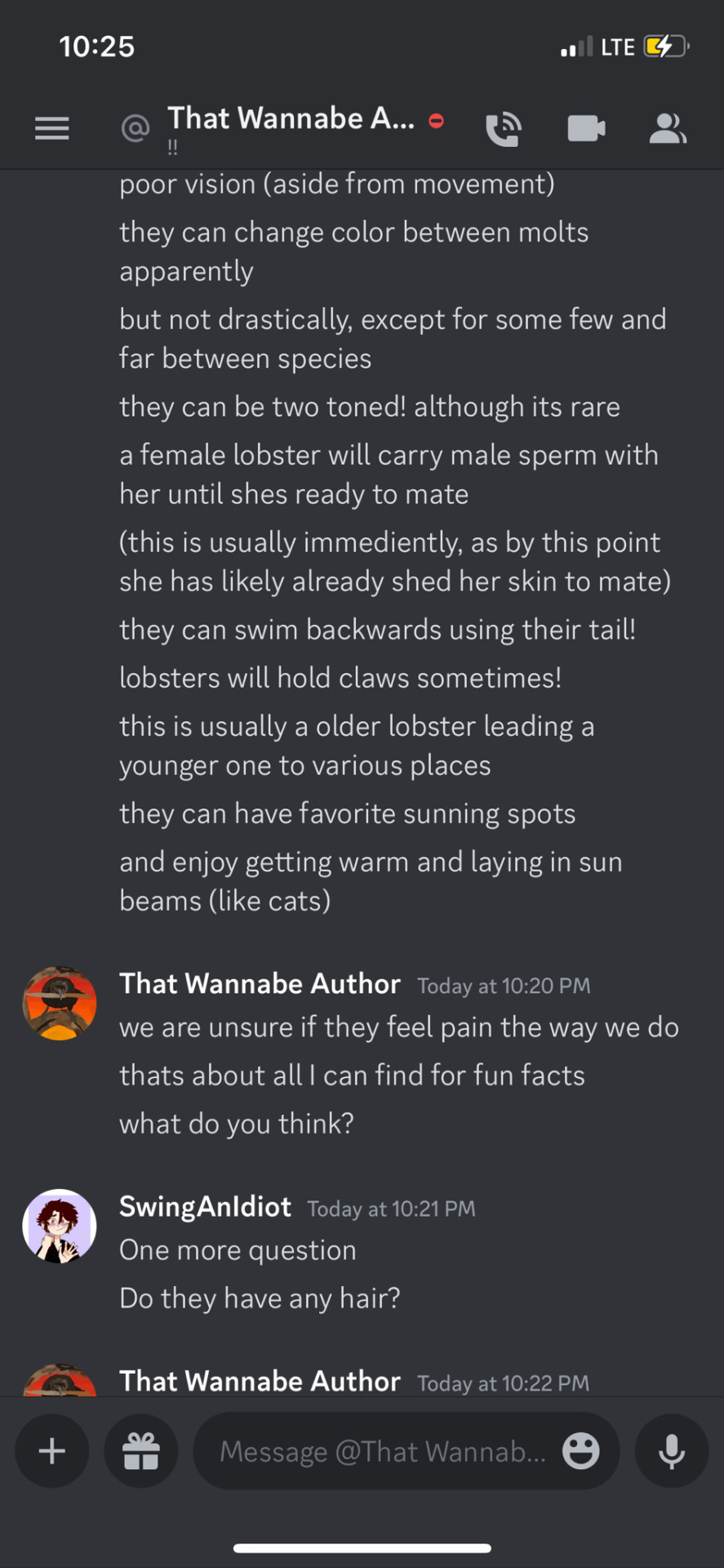
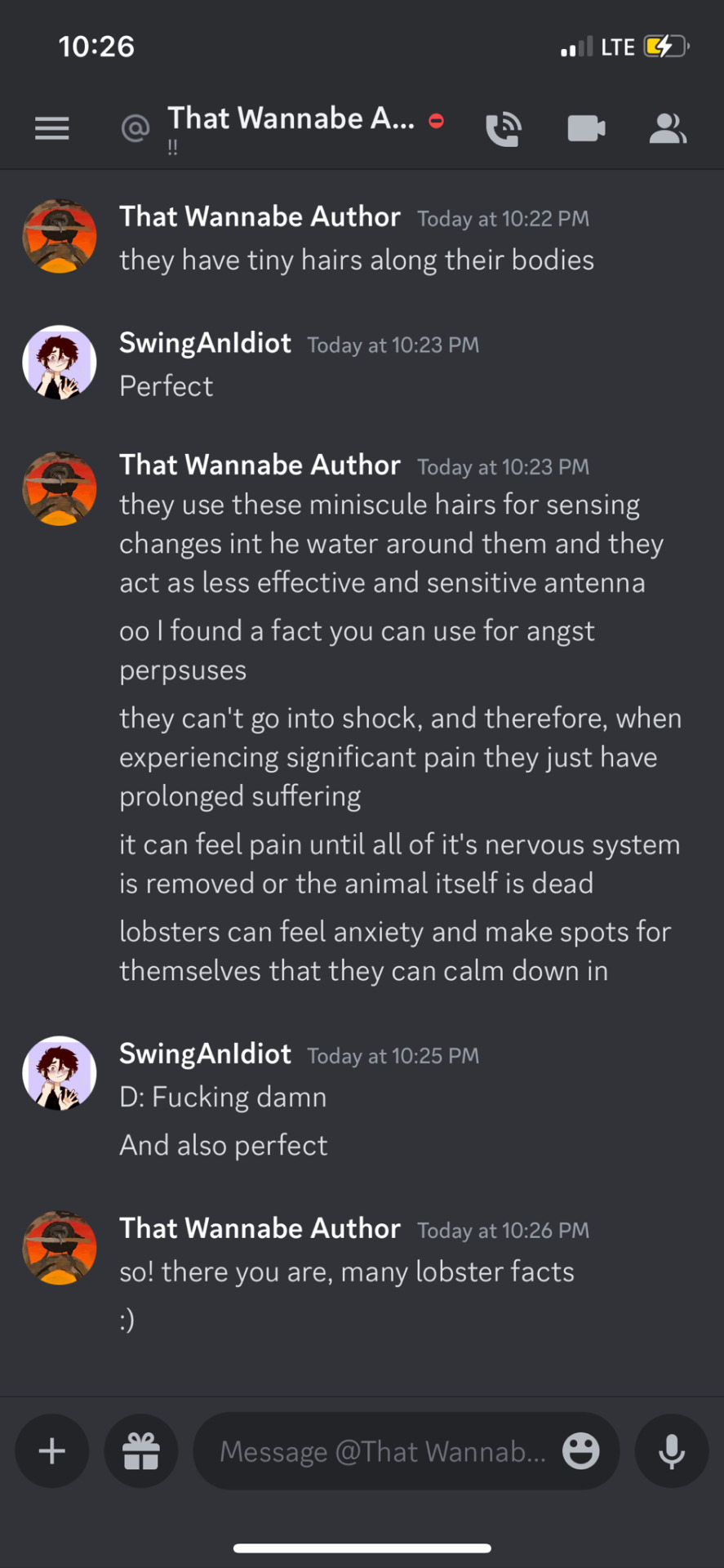
[ID: A discord conversation between That Wannabe Author and SwingAnIdiot.
SwingAnIdiot: Please tell me everything you know about lobsters
That Wannabe Author: !!!!!!
ok ok ok ok so lobsters fucking love those guys
so they're crustations and arthropods
related to shrimp and crabs and barnacles
known for the armoring around them, and found along almost all coastlines (i think, I might be thinking or crabs)
they’re omnivores
they've been around for years and years and years, there’s a million differnet fossils on them
this one isn't a lobster fact but a crab one but the process of evolving to become a crab is called "carcinization" as it is the perfect evoltionary form
thats, about all that comes to mind when I think of them, I'm not all too knowledgeable when it comes to crustations yet
Reaction of a Purple Heart emoji
SwingAnIdiot: Uhhh what about temperatures they’re able to withstand
Can they handle the cold?
Family habits?? Mating? Like multiple partners or just one. Which parents raises the kid? Do they have funky genders like bees or frogs?
That Wannabe Author: I don't think so, I'm pretty sure they freeze pretty easily
Reaction of a Purple Heart emoji
SwingAnIdiot: How much pressure can their armor handle? If it breaks does it bleed? Is it part of their skin like a turtle?? I’ve never even eaten lobster before
Can their armor heal if damaged??
That Wannabe Author: ok ok I have to look up half of these but let me start with the ones I do know
Reaction of a thumbs up emoji
multiple partners, because I remember learning about how female lobsters will shed their skin to get with these like super strong "alpha" lobsters and then live with him until her skin grows back and then she just leaves
also, they have like a weird amount of peeing as a part of mating?
SwingAnIdiot: THEY CAN SHED SKIN????? EXPLAIN PLEASE
That Wannabe Author: they pee out of their faces, and also pee on one another to calm one another down, and also to fight, and also as like, a courting thing?
oh yeah they have molts
They like basically get too big for their exoskeleton and so they split it in half and grow a new one
they actually use this to mark female lobsters they are still fertile when fishing!
they like, put a notch in their tail if they find them with eggs so fishers down the line can see that this is a reprductive female and put them back in the water
evidentally they don't raise their young and instead nurture the eggs until they hatch and then just send them off into the wild to fend for themselves
so, neither parents raises the kid
they’re all just neglectful!
so, from what I'm reading they don't have funky genders? But they're genders are determined by a gland that they either can or cannot inherit, and without it they just become female
and also male lobsters can just. Lose the gland? over time? and then they just become female
So
SwingAnIdiot: Huh
That Wannabe Author: good for them
apparently the university of tasmaia is working on this tech that'll change the genders of lobsters
found an article on that
SwingAnIdiot: Wicked!! Help over poaching and fear of extinction!!
That Wannabe Author: !! yeah!
holy shit their armour is like
one of the strongest materials we've found in nature apparently
SwingAnIdiot: Stronger than spider webs or diamonds???????
That Wannabe Author sends a cropped screenshot that says, “The team’s results show that the lobster membrane is the toughest material of all natural hydrogels, including collagen, animal skins, and natural rubber. The membrane is about as” the rest is cut off.
SwingAnIdiot: Damn
That Wannabe Author sends a cropped screenshot that says, “According to Robert Bayer, Executive Director at the Lobster Institute, good-sized lobsters can raise a pressure clothing strength of 100 pounds per square inch. The crushen-” the rest is cut off.
huh, thats amazing
lobsters have blue blood
but they don’t bleed very much because theyre blood clots really quickly \
it’s actually apparently one of their biggest killers, (outside of predator's and us)
SwingAnIdiot: !!!
That Wannabe Author: their blood will just. clot in a bad spot, usually around the heart or halting the nervous system, and then it'll kill them
SwingAnIdiot: Will be noting lots of this down
SwingAnIdiot: So I imagine their armor can scar right? And is it like reptiles in how they shed? Do they have more or less kids than other like fish and stuff?? How sensitive is their antannae and armor and eyesight and hearing?? Can they regrow limbs?
That Wannabe Author: they can scar! but only under very specific circumstance where they start seeping various bacteria into their shell once theyre old enough to stop molting and it can cause scar tissue to form along their shell and make it so that they no longer able to heal scars along their shell
and not really like reptiles, because reptiles just kinda have it be like a big whole put together thing that slides off of them and they already have the new skin underneath (i might jsut be thinking about snakes) whereas lobsters rather split their old shell in half and it leaves them with no protection at all until they grow a new one back
I looked it up and it was like "only takes 2-3 hours to regrow." and then another was like "can take a week"
so, i’m gonna say depends on species
wayy less kids than fish
they have like 50,000 eggs in one go but only 2 -5 are expected to live
because after the eggs are released they float on the water surface and are usually ate before they have the chance to float to the bottom of the sea floor (4-6 weeks)
SwingAnIdiot: F
That Wannabe Author: they can regrow limbs!
especially claws and antennae
although it takes multiple years
and legs or other "less essential" limbs take slow
ok so lobster eyes basically work by reflecting light
so they can’t see in really bright areas, because it blinds them
and also they have thousands of "square tubes" that they use to see more in their eyes at a time,
and they use those as tiny right angles that reflect more like
they have a 180 degree field of view
and this website keeps telling me they have "x-ray" eyes and then not specifying what they mean?
a cropped screenshot that says, “How Lobster Eyes Work.
A lobster’s eye reflects the light beams, rather than by bending it through lenses found in human eyes. This reflected light sends all of the beams reflected by a particular light (like potential prey on the ocean floor) to the same focal point. Each eye, set on a movable stalk, has up to 10,000 facets that operate like many tiny eyes.
The lobster probably doesn’t see images, but its eyes can detect motion in dim light. In bright light, a lobster is probably blind. The long antennae are used to feel the area around a lobster. The four small antennae on the front of their heads are used to “smell” their food or chemicals in the water. The unique design of the lobster eye has been intensely studied to help researchers develop X-ray scanners.” There is a drawing of glasses with swirls in the lenses and lines exuding it, presumingly representing radiation, captioned, “Do Lobsters have x-ray vision?”
That Wannabe Author: so, yeah! very cool
Reaction of a Purple Heart emoji
ok so the antennae is really very sensitive
they use it for SO much
SwingAnIdiot: Any fun cool quirks?? Like penguins give pretty rocks or r they picky with living space or oooooo!! Sensitive antennae will fun to write societal norms around
That Wannabe Author: they use antennae for detecting like everything in their environment around them like salinity, Ph, they use it for smelling, andthey flick it around to figure out their surrondings along with flicking it to deterine what direction a smell is coming from
OK FUN QUIRKS
they have a dominent claw
they chew inside of their stomach (no teeth!)
poor vision (aside from movement)
they can change color between molts apparently
but not drastically, except for some few and far between species
they can be two toned! although its rare
a female lobster will carry male sperm with her until shes ready to mate
(this is usually immediently, as by this point she has likely already shed her skin to mate)
they can swim backwards using their tail!
lobsters will hold claws sometimes!
this is usually a older lobster leading a younger one to various places
they can have favorite sunning spots
and enjoy getting warm and laying in sun beams (like cats)
we are unsure if they feel pain the way we do
thats about all I can find for fun facts
what do you think?
SwingAnIdiot: One more question
Do they have any hair?
That Wannabe Author: they have tiny hairs along their bodies
SwingAnIdiot: Perfect
That Wannabe Author: they use these miniscule hairs for sensing changes int he water around them and they act as less effective and sensitive antenna
oo I found a fact you can use for angst purposes
they can't go into shock, and therefore, when experiencing significant pain they just have prolonged suffering
it can feel pain until all of it's nervous system is removed or the animal itself is dead
lobsters can feel anxiety and make spots for themselves that they can calm down in
SwingAnIdiot: D: Fucking damn
And also perfect
That Wannabe Author: so! there you are, many lobster facts
:) End ID]
10 notes
·
View notes
Photo

These gorgeous opalised fossils were found in the outback town of Lightning Ridge 😍💎 They come from organisms that were alive during the early cretaceous, back when a shallow sea covered inland Australia. 🐢 The first one is from a freshwater crayfish - they used this "yabby button" to store minerals for hardening their exoskeletons after they malt. The next one is a pine cone, followed by two teeth: a crocodile and a theropod dinosaur tooth. On the bottom row is a pine cone, snail, turtle vertebra and sauropod dinosaur tooth. 🐌 🐊 📷 : Robert A. Smith/Australian Opal Centre
45 notes
·
View notes
Photo

I see restorations of arthropleura fly around the internet sometimes with “FUUUUCK THAT!!! ALL ABOARD THE NOPE TRAIN!!!” and just feel it’s worth pointing out that even today’s lighter, tinier millipedes move at a turtle-like pace and this one would have had to be even more easygoing due to its weight. It likely couldn’t have even lifted its front off the ground without something to prop up on, and the only thing we’ve ever found in its fossilized gut is plant pollen. A single modern rat would have been able to kill a full grown Arthropleura by sitting on top of it and chewing a hole in its exoskeleton. It would have no defense against that whatsoever and that is in fact how even the smallest rodents can decimate populations of the modern coconut crab or giant weta. Having an arthropleura in your house would probably be like having a very long and sleepy roomba.
5K notes
·
View notes
Text
The Amazon Jungle of the ocean, otherwise known as the Coral Triangle, is home to 76% of the world's coral species as well as 52% of Indo-Pacific reef fish, 37% of which are included in the world reef fish species. Of the 76% of coral species, 600 are reef-building. The Coral Triangle also provides habitat to 6 of the world's 7 marine turtle species. With the highest diversity of coral reef fish in the world and the greatest extent of mangroves, the Coral Triangle is a huge deal in the marine biologist world as well as surrounding communities. Scientists believe the reefs we know today were scattered across the globe by the currents flowing through the Coral Triangle. Discoveries of coral fossils taken in the Coral Triangle have shown that this was were the first reefs began after the ice age melted away. With 5.7 million square kilometers (2,200,000 sq mi) being included as the triangle, many countries benefit from the ecosystems. These include: Indonesia, Malaysia, Philippines, Papua New Guinea, Tmor Leste, and the Solomon Islands.
There are many factors that make the Coral Triangle special such as coral growth rates which are extremely fast in that area when compared to other reef areas on Earth. In other reef areas, such as The Great Barrier Reef, coral can take up to 50 years to grow but within the Coral Triangle, branches can be formed in a mere 15 years. With strong currents pulling cold water through, the temperatures there are neutralized year-round. The addition of fresh water circulating also provides oxygen from the floor to the surface. This way, growing conditions are optimal and the constantly flowing tides can move coral polyps around the world with ease.
As mentioned before, the Coral Triangle covers a particularly large area. With influences in so many areas its easy to say if anything were to happen to the reef millions would suffer. In fact, 120 million people live and rely on the Coral Triangle for food, income, and protection. Since tuna frequently spawn in the area, many of those people are tuna fishers and make their living that way. Others may hunt the whales, dolphins, dugongs, and whale sharks that breed and migrate there every year. While all of this sounds good for the economy, climate change and destructive fishing methods are starting to hurt the reef in ways that might not be recoverable.
Since the reef is important to multiple countries and cultures, the Worldwide Wildlife Fund (WWF) is pairing with their communities to make changes. In Papua New Guinea, they have started mangrove nurseries to help protect the coasts from damage as ocean levels rise each year. A documentary film made for the Solomon Islands shows the people current situations and traditional views in order to start climate change action within the peoples. With climate change being a large factor in the Coral Triangle's rapid deterioration, coral bleaching is being looked into and monitored closely. With oceanic temperatures rising, ocean acidification increases, and higher water levels, widespread bleaching of the corals has started to take over.
With much of the reef dying out, local communities' food, income, and protection are threatened. Without the reef to provide coastal protection or shelter for the fish, people's homes and families are faced with homelessness and starvation in some areas. The people surrounding the Coral Triangle have depended on it for generations thus they don't have much time to adapt to life without such a large resource. The WWF's efforts are helping, but if CO2 levels continue to effect ocean temperatures and acidity, the reefs could be damaged beyond repair. Along with coral reef death, fish are effected as well.
Shellfish like shrimp, crab, and lobster are at high risk of death when ocean acidic levels rise. The increase causes problems in their ability to form hard exoskeletons that protect them from predators. To go along with this, rising tide and water levels have been known to affect turtles. Since 6 out of the world's 7 species live in the Coral Triangle, many on the endangered species list, this is a large problem as well. Higher water levels also effect the surrounding coastal communities in that increased flooding and damage can occur. These factors have helped in deeming the Coral Triangle as a global priority for conservation around the world. With the WWF involved with communities in Indonesia, Malaysia, Philippines, Papua New Guinea, Tmor Leste, and the Solomon Islands, improvements have been made but significant change is yet to come.
[ sources ]
1 note
·
View note
Text
Climate Change and Human Activity: Are we the cause?
My name is Alyce Crane and I go to Tarleton State University. I’m currently majoring in Wildlife Science, and I hope to use what I’ve learned to help the environment. I have experience in the forestry service and experienced the changes that human life can do to the environment. In the following entries I have researched what we as humans have done to the environment and the changes that were recorded by researchers themselves, how plants and animals are affected by these changes, and how can we slow them down.
What’s climate change?
Bill Nye explains exactly what climate change is. He talks about the consequences of the human race advancements. Bill also discusses how you can slow this process down. Chick here for the link.
Has the environment changed in a good or bad way? Why?
Karina Acevedo et al addressed that environmental changes have negatively impacted most of the planet. Her paper explains four factors that seem to have persuaded the team into thinking that the planet is going to towards a negative time. The research done on birds to test whether the immune system was a factor predicted a significant amount of survival variation. Environmental stress and immune competence were broken into two categories, stress-induced immunosuppression, and pollutant-induced immunosuppression. Influence of human behavior can cause wildlife diseases by studying climate change, droughts, a complex disease that appears in California sea lions called urogenital cancer, and UV radiation. The last factor discussed how the success rate of reproduction and growth of offspring is due to the immune malfunctions being caused by previously mentioned factors. Link.
Prevent Climate Change mentions the top five ways the climate has changed in a negative way. A few that are mentioned are rising temperatures, melting ice caps, rising sea levels, weather conditions becoming more extreme, and most importantly the ecosystems changing. From the information given it seems that when one occurs such as rising temperatures another appears like melting ice caps which causes rising sea levels. Link.
Jason Meyers made a video called “Is Global Warming Good?” which talks about whether this is a good or bad thing. He never really gives a definite yes or no answer, but from his examples, he leans more on climate change being bad for humans. Link.
Have we caused any damage?
According to World Wildlife Fund (WWF), we are the main cause of the climate changing. We’ve released a huge amount of carbon dioxide into the atmosphere, and usually, there had been enough trees to soak up the CO2. We’ve cut down trees which releases the stored CO2 into the atmosphere once more as oxygen. The amount of carbon dioxide that’s released is more than what the trees left can handle. The article also describes the animals and regions that have been affected by the damage that we are continuing to do. Link.
Who has been affected by the climate change?
According to U.S. Department of the Interior, there are nine animals that are being affected by the climate change. Moose, salmon, snowshoe hares, American pikas, sea turtles, puffins, Alaskan caribou, piping plovers, and polar bears are all mentioned in this article as well as how they have been affected. Link.
According to The Wildlife Society, sea turtles have been affected by the climate change. The rising temperatures cause the sand to dry out, and as a result, a vital protein which determines whether they will be male or female is becoming scarce. Link.
Arkive describes how the Quiver tree has been affected by the climate change. They predict that rain will become scarce and the trees won’t adapt quickly enough to accommodate the insects and animals that benefit from these Quiver trees. Link.
Prevent Climate Change describes that human activity that emits CO2 into the atmosphere is absorbed by the ocean. The acidity of the ocean is predicted to increase dramatically in the next millennium. The acidity levels increase leaving the marine life in devastation. A protein that helps create the exoskeleton of some organisms is threatened. Link.
A podcast by Science Vs called “Climate Change…the Apocalypse?” discusses the main factor of fossil fuels being released from human activity. Professor Ralph Keeling tests the air to record the CO2 levels over the years. Another professor and a doctor appear on the show to discuss the future of the planet. They spoke about some things that may be the reason why the temperature is rising. They were discussing whether the number of volcanic eruptions had anything to deal with the temperature. They go on talking about the future and where we stand on the environmental devastation. Link.
NERC Science of the Environment Planet Earth created a podcast called “Marine life and climate change” which discussed how past microscopic organisms have been absorbing carbon dioxide for millions of years. Jason Hopkins and Paul Brown have done experiments to recreate what possibly could have caused them to slow down change. They believe that at one point there were all kinds of different species of micro-organisms related to the ones that had little change but went extinct due to severe changes in their environment. Link.
Susan Poizner talks on a podcast called “Climate Change and Fruit Trees” that discusses what happens to our fruit trees during this climate change. Gregory Peck talks about what happens to the trees when they have early bud break and frost hits and how you can accommodate this change in climate. Link.
What can we do to slow down the changes?
Al Gore wrote Our Choice: A Plan to Solve the Climate Crisis that discusses how we have the tools to solve the problems that we’ve caused but we don’t have the habits and the political-culture that can prevent our ability to change. Al Gore writes about a call to action that will take commitment on our part. Link.
Prevent Climate Change discusses a few different ways to slow down the rapidly changing environment. A few ways they mention are making your home more energy efficient, how to make your lifestyle greener, changing habits at work, and eating less meat. Link.
0 notes
Text
Miami’s Sprawling Frost Science Museum Is Finally Open
The Phillip and Patricia Frost Museum of Science opened to the public on May 8, and it's a sprawling, open-air, Death Star-shaped shrine to nature, with exhibitions dedicated to the cosmos, Florida's fragile ecosystem, and the phenomena of the human body.
It was a long time coming: the massive architectural project was stalled two years ago due to funding issues, until Miami-Dade County helped provide the remaining funds. For years, the museum looked like a spherical, concrete exoskeleton. Now, that orb is a 250-seat planetarium, the screen tilted at 23.5 degrees, just enough to make you feel like you're flying. On opening day, the planetarium screened the dizzying Asteroid: Mission Extreme, a 3D special narrated by Sigourney Weaver.
MeLab at Frost Science. Courtesy of World Red Eye.
Future planetarium programming includes laser light shows every first Friday of the month, film screenings curated by Science/Art Cinema, sky-gazing with telescopes, and galactic adventures. Expect upcoming shows to be interactive. As Dr. Jorge Perez-Gallego, Curator of Astronomy and Exhibition Developer, explains, "Because of the software we have in our system, we can actually go anywhere in the galaxy in real time, and take these journeys in 3D. I can ask the audience, 'Which planet do you want to visit? Which moon?' People will feel they own the experience, and each show will be a little different."
The planetarium is indicative of the museum's future plans to bridge science, technology, and the arts, an effort to both acknowledge the community's support of the museum and to cultivate genuine curiosity. "We want to open the planetarium to the creative community," says Perez-Gallego, who is a designer as well as an astrophysicist. "I understand the way that artists can actually help push technology. A science museum is like science itself; it's something that is never done. We have been literally supported by our community, so we owe it to them to listen."
Dive Level at Frost Science. Courtesy of World Red Eye.
One of the most beautiful parts of the museum is its 500,000-gallon aquarium, divided into three stories—Vista, The Dive, and The Deep. The Vista, located on the museum's rooftop, offers sprawling views of Biscayne Bay, an aviary, and the opportunity to see creatures like stingrays, owls, and alligators (they'll be released into the wild next year). References to the precious Everglades and its current state are everywhere, including River of Grass, an interactive exhibit designed for small children.
Visitors peer into the tops of pools of fish that stretch into the interactive Dive floor below, which is replete with corals, fossils, and a VR adventure from the P.O.V. of a shark. The Deep is filled with jellyfish and, steps away, a majestic, 31-foot-wide oculus lens, providing a view into a Vista-level tank—the oculus is looming, and mahi-mahi, rays, and hammerhead and tiger sharks swim overhead.
Feathers to the Stars at Frost Science. Courtesy of World Red Eye.
Special exhibitions, like SEEING—which debuted at Ireland's Science Gallery Dublin—examine the concept of vision through robots that draw your portrait, a digital canvas painted by your eye movements, and a journey through the eyes of a synesthete. In a dark room illuminated with red and green lasers, LASERsHOW teaches visitors about the creation and purpose of lasers. A permanent exhibit, Feathers to the Stars, explores the history of flight, from feathered dinosaurs to space travel. Here, you'll find a 30-foot Yutyrannus, a feathery, cone-toothed dinosaur whose name literally means "feathered tyrant."
Across the room, past the paper airplane-making station and the big-screen visuals of satellites in space, there's a unique gem: a display case entitled Dreams of a Future. An homage to human's ongoing fascination with the cosmos, it's crammed with nostalgic ephemera like mugs, books, records, and action figures. Curator Kevin Arrow, the museum's Art and Collection Manager, crystallizes the display and the mission of the museum itself. "From the earliest days of the space program, scientists have drawn and shared inspiration with writers, artists, and creative thinkers," he says. "What was considered science fiction in the past is today our scientific reality. Imagination triggers innovation and innovation triggers imagination."
Vista Level - Atrium View of Frost Science. Courtesy of World Red Eye.
MeLab at Frost Science. Courtesy of World Red Eye.
Frost Science from Science Plaza. Courtesy of World Red Eye.
Sandy Shores at Frost Science, with a sea turtle nesting area. Courtesy of World Red Eye.
Florida Reef at Frost Science. Courtesy of World Red Eye.
Atrium at Frost Science. Courtesy of World Red Eye.
The Frost Museum of Science is open every day of the year. For ticket and schedule info, click here. Summer 2017 Laser Light Shows at the Planetarium begin Friday, June 2 at 7PM.
Related:
Scientists Discovered a Dinosaur Tail Covered In Feathers | Last Week in Art
Watch a Planetarium Dome Become a Real-Time Audiovisual Canvas
Is This the Digitized Aquarium of the Future?
from creators http://ift.tt/2qAzumI via IFTTT
0 notes